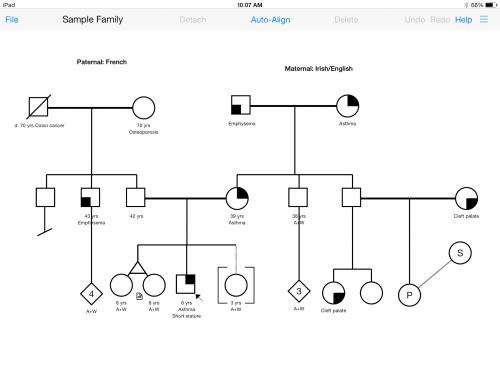With a few finger taps, draw genetic pedigrees at point of care with new app

Long before next-generation sequencing technology ushered in today's data-intensive era of human genome information, clinicians have been taking family histories by jotting down pedigrees: hand-drawn diagrams recording how diseases may recur across generations, and offering clues to inheritance patterns.
Now healthcare providers can create those diagrams digitally on an iPad screen with a few finger taps, during a face-to-face encounter with an individual and his or her family. Users can store the pedigrees in a standardized format, make corrections flexibly as they gather new information, and export the diagrams so they can be used in other applications such as electronic medical records.
"Instead of storing a pedigree on a piece of paper in a physical file, we can capture the information with an easy-to-use interface that produces accessible data," said Jeff Miller, lead analyst at the Center for Biomedical Informatics (CBMi) at The Children's Hospital of Philadelphia. Miller led the CBMi team that developed the Proband app, which made its debut today on the iTunes App StoreSM. Genetic counselors, clinical genetics specialists and others can download the app for a limited-time introductory price of $1.99.
Designed for use as a data collection tool during a genetic counseling interview or in similarly interactive settings, Proband uses a simple, gesture-based interface to make drawing pedigrees as efficient as drawing on paper. Users can quickly create even the most complex family pedigrees simply and easily using standard nomenclature and symbols. "We designed this app for ease of use with options appearing as you need them," said Miller. "Our goal is to make those features contextually relevant, and not to overwhelm the user."
Mindy Li, M.D., a clinical genetics fellow at CHOP, is one of those who helped test the app, providing critiques and feedback to the CBMi development team. "One strength for me as a clinician is being able to set the device on my lap while I conduct an interview—it's a better interaction than if I had to turn toward a computer screen and input the information," she said.
A suggestion of hers that was incorporated, said Li, was to allow for careful spacing and alignment, to make it clear which individuals belong to each generation: "Alignment is important—you have to see children in their correct generation." An auto-alignment button on the app screen helps to straighten that out. She added, "As health technology in general is moving toward electronic data, it's important to have pedigrees easy to read and easy to integrate." Compared to reviewing traditional hand-drawn pedigrees, she doesn't have to decipher someone else's handwriting or idiosyncratic abbreviations.
Miller and other team members are presenting Proband at the annual meeting of the American College of Medical Genetics and Genomics, March 28 in Nashville.
More information: For more information, visit probandapp.com




















